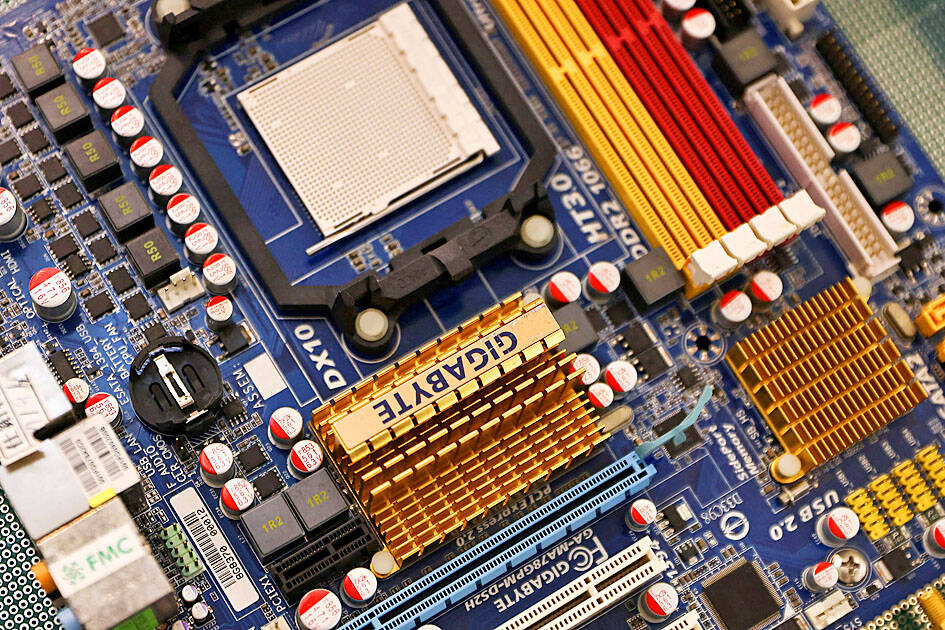Vanguard International Semiconductor Corp (世界先進) yesterday said revenue this quarter would drop by about 15 percent from last quarter, as customers digest inventory amid sluggish demand for consumer electronics during the slow season.
Vanguard, which makes driver ICs used in displays and power management chips, joined its global peers in giving a bleak outlook for the current quarter.
Revenue is expected to fall for a third consecutive quarter to between NT$7.9 billion and NT$8.3 billion (US$259.7 million and US$272.9 million) this quarter, compared with NT$9.57 billion the previous quarter, Vanguard said.

Photo: Ann Wang, Reuters
Its factory utilization rate is expected to fall by 10 percentage points this quarter, as customers continue to scale down orders, the chipmaker said.
The expected decline does not fully reflect the extent of an industry slump, as Vanguard has allocated a small part of its manufacturing capacity to help customers “pre-build” chip inventory for shipments at a later date.
Gross margin is expected to slide to 29 to 31 percent this quarter, from 39.2 percent last quarter, approaching the lowest level since the first quarter of 2020, the company said.
Falling average selling prices are also weighing on gross margin this quarter, the chipmaker said.
“We are working with customers to deal with the severe inventory correction cycle, as end-product market demand is depressed by the macroeconomic situation,” Vanguard chairman Fang Leuh (方略) told an online investors’ conference.
“The first quarter should be the coolest season as indicated by macroeconomy and customers’ expectations. That will be followed by a gradual recovery, but we are not clear how fast the recovery will be,” he said.
Vanguard said that it has seen inventory pressure mainly from driver ICs used in notebook computer displays, power management chips and industrial segments, such as data centers.
Driver ICs used in TV displays are expected to hit the bottom this quarter, it said.
Power management chips contributed 78 percent to Vanguard’s revenue last quarter.
In response to the slowdown, Vanguard halved its capital expenditure this year to about NT$10 billion, from NT$19.4 billion last year, by postponing the delivery of some new manufacturing equipment.
More than half of the capital expenditure would be allocated to building a new fab, Fab 5, and boosting wafer capacity there, the chipmaker said.
Vanguard would carry out its capacity expansion plans despite the industrial downturn, as it is obligated to supply wafers to customers based on long-term agreements signed before market sentiment soured.
The investment would help boost its manufacturing capacity by 8 percent this year from last year, the chipmaker said.
Vanguard said it is evaluating the possibility of investing in a new 12-inch factory to satisfy customers’ long-term demand for wafers.
Cost inefficiency makes it infeasible to invest in another 8-inch fab, it said.
Vanguard operates five 8-inch fabs.

The US dollar was trading at NT$29.7 at 10am today on the Taipei Foreign Exchange, as the New Taiwan dollar gained NT$1.364 from the previous close last week. The NT dollar continued to rise today, after surging 3.07 percent on Friday. After opening at NT$30.91, the NT dollar gained more than NT$1 in just 15 minutes, briefly passing the NT$30 mark. Before the US Department of the Treasury's semi-annual currency report came out, expectations that the NT dollar would keep rising were already building. The NT dollar on Friday closed at NT$31.064, up by NT$0.953 — a 3.07 percent single-day gain. Today,

‘SHORT TERM’: The local currency would likely remain strong in the near term, driven by anticipated US trade pressure, capital inflows and expectations of a US Fed rate cut The US dollar is expected to fall below NT$30 in the near term, as traders anticipate increased pressure from Washington for Taiwan to allow the New Taiwan dollar to appreciate, Cathay United Bank (國泰世華銀行) chief economist Lin Chi-chao (林啟超) said. Following a sharp drop in the greenback against the NT dollar on Friday, Lin told the Central News Agency that the local currency is likely to remain strong in the short term, driven in part by market psychology surrounding anticipated US policy pressure. On Friday, the US dollar fell NT$0.953, or 3.07 percent, closing at NT$31.064 — its lowest level since Jan.

Hong Kong authorities ramped up sales of the local dollar as the greenback’s slide threatened the foreign-exchange peg. The Hong Kong Monetary Authority (HKMA) sold a record HK$60.5 billion (US$7.8 billion) of the city’s currency, according to an alert sent on its Bloomberg page yesterday in Asia, after it tested the upper end of its trading band. That added to the HK$56.1 billion of sales versus the greenback since Friday. The rapid intervention signals efforts from the city’s authorities to limit the local currency’s moves within its HK$7.75 to HK$7.85 per US dollar trading band. Heavy sales of the local dollar by

The Financial Supervisory Commission (FSC) yesterday met with some of the nation’s largest insurance companies as a skyrocketing New Taiwan dollar piles pressure on their hundreds of billions of dollars in US bond investments. The commission has asked some life insurance firms, among the biggest Asian holders of US debt, to discuss how the rapidly strengthening NT dollar has impacted their operations, people familiar with the matter said. The meeting took place as the NT dollar jumped as much as 5 percent yesterday, its biggest intraday gain in more than three decades. The local currency surged as exporters rushed to